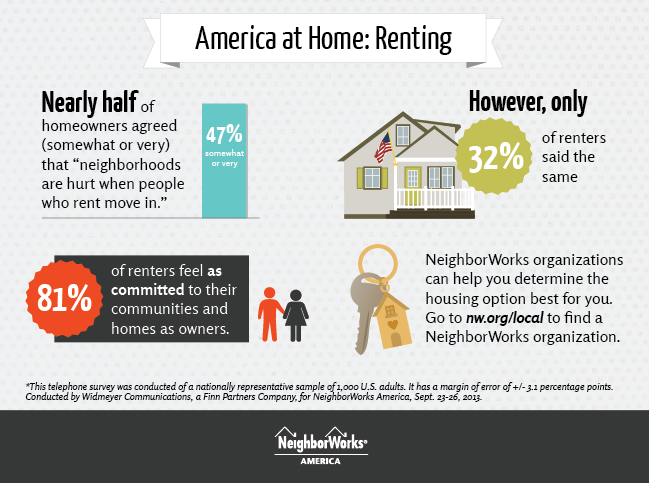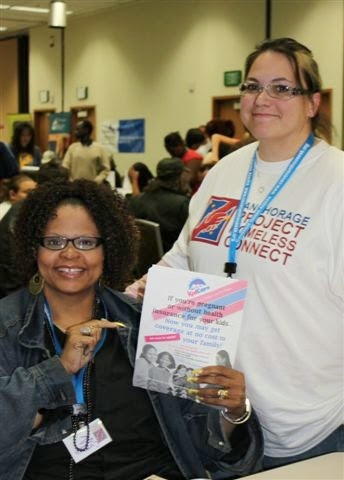By Pam Bailey, NeighborWorks America blogger
Surveys show wide disparities between perceptions of renters vs. homeowners – some based on reality, and others that are not. Many of the problems could be alleviated, however, if more programs encouraged neighbor-to-neighbor social connections, rather than owners to renters.
That’s the aim of programs like NeighborCircles, sponsored by Lawrence (MA) CommunityWorks. The concept is simple: Residents recruited as “circle hosts” invite five to 10 neighbors – ideally from homes they can see from their own yards – to a series of three dinners over the course of a month, designed to both connect them to each other and unite them in a common project to improve their community.
“In 2008, about 75 percent of the houses in our neighborhoods were at some point in the foreclosure process. A lot of people left the community,” explains Spencer Buchholz, director of network organizing for Lawrence CommunityWorks. “I’d say that today, about 80 percent are renters, mixed in with the original homeowners.”
The first dinner, led by two facilitators trained by Buchholz’ team, is designed to build common bonds. The facilitators lead the group in an ice-breaker in which each person literally traces on a world map their family’s journey to Lawrence, MA. More than 70 percent of residents come from Latino immigrant families, originally from places as far flung as the Dominican Republic and Puerto Rico. “They tell each other how and why they got to Lawrence and what keeps them here,” explains Buchholz.
In the second and third meetings, circle participants discuss the quality of life in their neighborhood, the improvements they’d like to see and how they could join together in a project to accomplish one of those goals – whether it be a street clean-up, a petition to the city council to repair sidewalks or a meeting with the police department on neighborhood crime prevention.
“Our goal is to build social capital,” says Buchholz, adding that his team coordinates an average of about 12 circles a year – approximately 130 to date. “Now participants know who is across the street, and they can watch each other’s houses when someone is gone. It’s all about connection...finding common interests across the divide.”
The NeighborCircle concept is easy to adapt to other locales and situations, and Buchholz’ team has trained groups in states from Massachusetts to Arizona to implement their own.
Taking a similar approach is Neighborhood Housing Services of Chicago, which works with community leaders (some of whom serve on the organization’s advisory council) to form block clubs, with leaders specifically trained to engage renters. One recent survey, for instance, found that while 61 percent of homeowners know their neighbors’ names, that’s true for only 39 percent of renters.
“Renters are usually not there permanently, and fixing up the property is the owner’s or manager’s responsibility. And they’re often not really encouraged to feel involved in any case,” explains Janece Simmons, neighborhood director for NHS of Chicago. “It’s the job of local organizations and our block club leaders to take a holistic approach in their outreach; after all, the neighborhood is where renters’ children walk and play too. They need to be included in planning activities like planning block club parties and improvement projects. Plus, for us, outreach is a great way to connect renters to the information and resources that can help prepare them to become homeowners someday.”
NHS of Chicago has been helping organize block clubs since 1975, and there are currently about 100 active groups in the Auburn-Gresham community, says Simmons -- many of which have been active for years. Representatives from each of the clubs meet monthly, giving new members the opportunity to learn from the “veterans,” as well as hear about grant opportunities, etc.
“Through the block clubs, homeowners have come to welcome renters’ involvement,” says Simmons. “And renters soon come to see that their participation makes a difference, for them and the community.”
Surveys show wide disparities between perceptions of renters vs. homeowners – some based on reality, and others that are not. Many of the problems could be alleviated, however, if more programs encouraged neighbor-to-neighbor social connections, rather than owners to renters.
That’s the aim of programs like NeighborCircles, sponsored by Lawrence (MA) CommunityWorks. The concept is simple: Residents recruited as “circle hosts” invite five to 10 neighbors – ideally from homes they can see from their own yards – to a series of three dinners over the course of a month, designed to both connect them to each other and unite them in a common project to improve their community.
“In 2008, about 75 percent of the houses in our neighborhoods were at some point in the foreclosure process. A lot of people left the community,” explains Spencer Buchholz, director of network organizing for Lawrence CommunityWorks. “I’d say that today, about 80 percent are renters, mixed in with the original homeowners.”
 |
| At one NeighborCircles, participants trace on a map their families' journey to Lawrence, MA. |
In the second and third meetings, circle participants discuss the quality of life in their neighborhood, the improvements they’d like to see and how they could join together in a project to accomplish one of those goals – whether it be a street clean-up, a petition to the city council to repair sidewalks or a meeting with the police department on neighborhood crime prevention.
“Our goal is to build social capital,” says Buchholz, adding that his team coordinates an average of about 12 circles a year – approximately 130 to date. “Now participants know who is across the street, and they can watch each other’s houses when someone is gone. It’s all about connection...finding common interests across the divide.”
The NeighborCircle concept is easy to adapt to other locales and situations, and Buchholz’ team has trained groups in states from Massachusetts to Arizona to implement their own.
 |
| Block club members work to improve neighborhood conditions for children. |
“Renters are usually not there permanently, and fixing up the property is the owner’s or manager’s responsibility. And they’re often not really encouraged to feel involved in any case,” explains Janece Simmons, neighborhood director for NHS of Chicago. “It’s the job of local organizations and our block club leaders to take a holistic approach in their outreach; after all, the neighborhood is where renters’ children walk and play too. They need to be included in planning activities like planning block club parties and improvement projects. Plus, for us, outreach is a great way to connect renters to the information and resources that can help prepare them to become homeowners someday.”
NHS of Chicago has been helping organize block clubs since 1975, and there are currently about 100 active groups in the Auburn-Gresham community, says Simmons -- many of which have been active for years. Representatives from each of the clubs meet monthly, giving new members the opportunity to learn from the “veterans,” as well as hear about grant opportunities, etc.
“Through the block clubs, homeowners have come to welcome renters’ involvement,” says Simmons. “And renters soon come to see that their participation makes a difference, for them and the community.”












